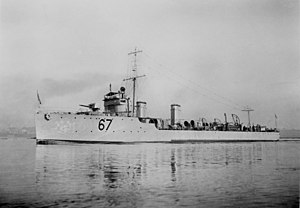HMAS Torrens (D67)
 HMAS Torrens
| |
| History | |
|---|---|
| Namesake | The River Torrens |
| Builder | Cockatoo Docks and Engineering Company |
| Laid down | 25 January 1913 |
| Launched | 28 August 1915 |
| Commissioned | 3 July 1916 |
| Decommissioned | 19 July 1920 (to reserve) |
| Reclassified | Training ship (1920–1925) |
| Honours and awards |
|
| Fate | Sunk as target 24 November 1930 |
| General characteristics | |
| Class and type | torpedo-boat destroyer |
| Displacement | 750 tons |
| Length |
|
| Beam | 24 ft 3.625 in (7.40728 m) |
| Propulsion | 3 × Yarrow boilers, Parsons turbines, 10,000 shp (7,500 kW), 3 shafts |
| Speed | 26 knots (48 km/h; 30 mph) |
| Range | 2,690 nautical miles (4,980 km; 3,100 mi) at 11.5 knots (21.3 km/h; 13.2 mph) |
| Complement | 5 officers, 67 sailors |
| Armament |
|
HMAS Torrens, named for the
Design and construction
Torrens was one of six
The destroyer's main armament consisted of a
Torrens was laid down by
Operational history
Torrens and sister ship Swan were first assigned to the British Far East Patrol.[2] From September 1916 to May 1917, Torrens operated throughout Maritime Southeast Asia.[2] In June, the destroyer docked at Singapore for a refit.[2] after which Torrens and the other five River class vessels sailed for the Mediterranean.[2] After escorting a convoy from Port Said to Malta, and refits at the island, Torrens was assigned to Brindisi as part of the anti-submarine patrol force.[2] The heavy but monotonous workload forced the destroyer to visit Malta in December for another refit.[2]
On the night of 22–23 April 1919, Torrens was one of six Allied ships patrolling the Adriatic.[2] A force of five Austrian destroyers attacked, seriously damaging the British destroyers Hornet and Jackal before retreating faster than the Allied ships could pursue.[5] Apart from a brief refit at Messina in September–October, Torrens remained in the region until the end of World War I.[6] Her wartime service was later recognised with the battle honour "Adriatic 1917–18".[7][8] After returning to Australia in May 1919, Torrens was involved in routine duties.[6]
Decommissioning and fate
Torrens was paid off into reserve on 19 July 1920.

During the general reduction in naval activity imposed by lack of finance during the Great Depression, it was decided to scrap Torrens and her five sister ships.[6] On 24 November 1930, after being stripped of useful materials, Torrens was towed outside Sydney Heads by the tug Heroic, and was used for gunnery target practice.[6] The destroyer withstood considerable shelling before being scuttled by a charge of gelignite.[6] The wreck lies off Sydney in position 33°53′54″S 151°39′54″E / 33.89833°S 151.66500°E.[9]
Citations
- ^ a b c d e f g Cassells, The Destroyers, p. 138
- ^ a b c d e f g h i j k Cassells, The Destroyers, p. 139
- ^ Cassells, The Destroyers, pp. 138–9
- ^ "HMAS Torrens (I)". Ship Histories. Royal Australian Navy. Retrieved 6 May 2011.
- ^ Cassells, The Destroyers, pp. 139–40
- ^ a b c d e f g h i Cassells, The Destroyers, p. 140
- ^ "Navy Marks 109th Birthday With Historic Changes To Battle Honours". Royal Australian Navy. 1 March 2010. Archived from the original on 13 June 2011. Retrieved 23 December 2012.
- ^ "Royal Australian Navy Ship/Unit Battle Honours" (PDF). Royal Australian Navy. 1 March 2010. Archived from the original (PDF) on 14 June 2011. Retrieved 23 December 2012.
- ^ "Archived copy" (PDF). Archived from the original (PDF) on 20 April 2019. Retrieved 31 August 2019.
{{cite web}}: CS1 maint: archived copy as title (link)
References
- Briggs, Mark (2019). "Australia's First Destroyers". In Jordan, John (ed.). Warship 2019. Oxford, UK: Osprey Publishing. pp. 153–167. ISBN 978-1-4728-3595-6.
- Cassells, Vic (2000). The Destroyers: Their Battles and Their Badges. East Roseville, NSW: Simon & Schuster. OCLC 46829686.
